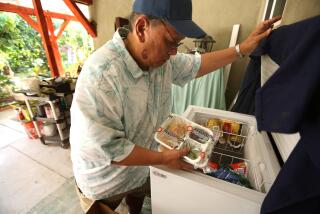Food Bank Study Finds Many Working Poor Among Clients
- Share via
The most familiar face of hunger in America is that of a homeless person waiting in line at the local soup kitchen.
But a study released Tuesday said the hungry in this country are more likely to live in a home and have at least one person in the household who works.
“Employment is on the rise, and so are the harsh realities at the bottom of the economic heap,” Los Angeles Regional Foodbank Executive Director Doris Bloch said.
Touted as the most comprehensive study of hunger in America, the survey was made public via the Internet and at news conferences in Washington, Los Angeles and other cities.
The study was commissioned by Second Harvest, a Chicago-based national network of hunger relief organizations that includes the Los Angeles Regional Food Bank. It surveyed nearly 28,000 food recipients at 11,000 charitable agencies around the country last summer.
Statistics for Los Angeles County were consistent with national data showing that people receiving food donations are in large part the working poor who have to make hard choices between food and other necessities like rent and medicine.
In Los Angeles, only 15% of food recipients were homeless, and 42% of those surveyed had at least one adult in the home who worked. Nationally those numbers were 16% and 39%, respectively. But when asked whether they ever had to choose between paying for housing or buying food, 62% in Los Angeles answered “yes,” compared with 35% nationwide.
“People are working, but they are still going hungry,” Bloch said at the news conference held inside the food bank’s warehouse near downtown. What the study shows is that “low-income people here are very low income,” she said.
Nationally and locally, more than two-thirds of households had annual income of less than $10,000--below the federal poverty guideline for a family of two.
Christine Vladimiroff, president and chief executive officer of Second Harvest, said: “One of the bases of welfare reform was that we need to put people to work. The study calls into question that assumption.
“Hunger is a symptom of poverty. It could be that the parents do not have the education to get the jobs, or that the jobs don’t pay well. Or it can be that housing is too expensive. There is not one answer, so there cannot be just one solution.”
Vladimiroff, who gave the study’s findings to members of Congress on Tuesday, said: “It is really important that in these wonderful and prosperous times of the American economy, we find the political will and moral outrage to really put an end to hunger.”
Previous studies have suggested that the hungry in this country are increasingly the working poor. A report by the United States Conference of Mayors last December said that almost 40% of those seeking food assistance were employed. Although Second Harvest’s study was first intended to examine the effects of welfare reform on hunger, Tuesday’s findings did not yield any firm new data on that subject.
“It is too early to tell,” Bloch said, adding that the study says “this is the way things look like now, but we don’t know what will happen in the future.”
However, she said limits on food stamps brought on by welfare reforms may explain why 64% of those seeking donated food in Los Angeles did not receive such assistance from the government. “They probably did not qualify.”
The findings did not surprise Jennifer Wolch, professor of geography and urban planning at USC and an expert on poverty and welfare policy. “An increasing number of poor families are going to skid row for food,” Wolch said. “Food stamps have been cut back and labor markets at the lowest reaches are producing jobs that do not pay sufficient wages or have enough hours.”
She said more studies are necessary to fully understand the long-term impact of welfare reforms.
Among other findings in Second Harvest’s study: Food aid recipients are twice as likely to be women as men, and an increasing number are children and senior citizens. Nationally, children and older people account for 45% of those receiving food aid--55% in Los Angeles County.
Tuesday also marked the end of a 24-hour fast sponsored by the regional food bank. About 200 people participated to increase awareness of hunger, said the food bank’s spokeswoman, Amanda Cooper.
Wilma Camacho, a journalist who participated in the fast, said she was inspired by the study to “feel what it’s like to go a whole day without eating.”
“I felt dizzy,” she said. “Imagine somebody who goes without food for two or three days.”
(BEGIN TEXT OF INFOBOX / INFOGRAPHIC)
Who Gets Food Aid
Among those receiving donations from food banks in Los Angeles County in 1997, more than 70%had household incomes of less than $10,000 a year, yet nearly half of households had at least one person holding a job.
*
Ethnicity
Nationwide
White: 44%
Other: 2%
Asian American: 2%
Native American: 2%
African American: 35%
Latino: 15%
*
L.A. County
White: 20%
Other: 5%
Asian American: 4%
Native American: 0.3%
African American: 26%
Latino: 45%
Note: Total may exceed 100% due to rounding.
*
Single-parent households
L.A. County: 26%
Nationwide: 33%
*
Job holders (Households with one or more adults employed)
L.A. County: 42%
Nationwide: 39%
*
Household income (Less than $10,000 a year)
L.A. County: 71%
Nationwide: 73%
Source: Second Harvest, 1997 survey, “Hunger: The Faces and Facts”
More to Read
Sign up for Essential California
The most important California stories and recommendations in your inbox every morning.
You may occasionally receive promotional content from the Los Angeles Times.










